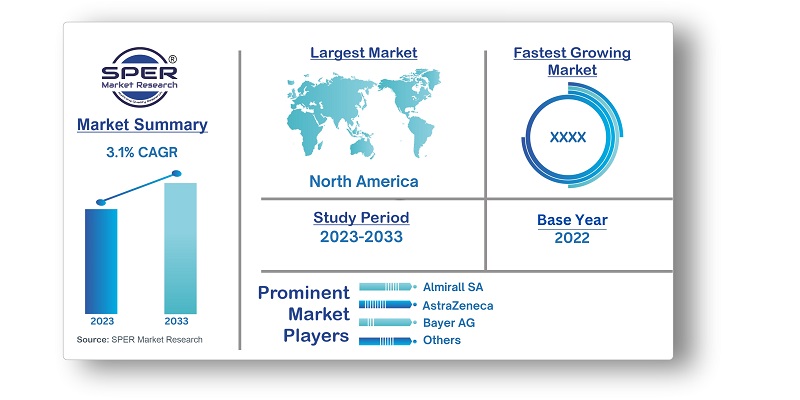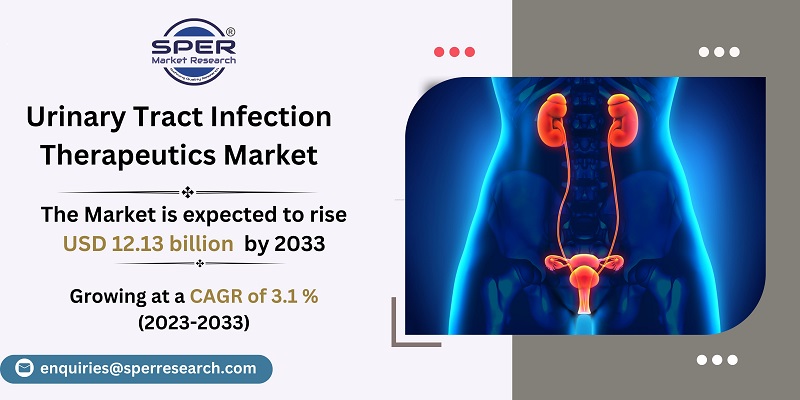
Urinary Tract Infection Therapeutics Market Growth, Trends, Size, Revenue and Future Outlook
Urinary Tract Infection Therapeutics Market Size- By Drug, By Indication- Regional Outlook, Competitive Strategies and Segment Forecast to 2033
| Published: Jan-2024 | Report ID: HLCA2411 | Pages: 1 - 235 | Formats*: |
| Category : Healthcare | |||
- October 2021: The US Food and Drug Administration (FDA) received a new drug application (NDA) from Spero Therapeutics Inc. requesting clearance for tebipenem HBr tablets to treat complicated UTIs (cUTIs), including pyelonephritis, brought on by susceptible microorganisms.
- September 2021: Biapenem was introduced by BDR Pharma, a top generic pharmaceutical company in India, to treat patients with urinary tract infections, lower respiratory infections, and intra-abdominal infections.


| Report Metric | Details |
| Market size available for years | 2019-2033 |
| Base year considered | 2022 |
| Forecast period | 2023-2033 |
| Segments covered | By Drug, By Indication |
| Regions covered | Asia-Pacific, Europe, Middle East and Africa, North America, Latin America |
| Companies Covered | Almirall SA, AstraZeneca, Bayer AG, Bristol-Myers Squibb Company, Cipla Inc., Dr. Reddys Laboratories Ltd, GlaxoSmithKline PLC, Merck & Co. Inc, Novartis AG, Pfizer, Shionogi & Co. Ltd., Others. |
- Pharmaceutical Companies
- Healthcare Providers
- Research and Development Teams
- Patients and Caregivers
- Health Insurance Providers
- Government Health Departments
- Pharmacy and Retail Chains
- Others
| By Drug |
|
| By Indication |
|
| By Region: |
|
- Global Urinary Tract Infection Therapeutics Market Size (FY’2023-FY’2033)
- Overview of Global Urinary Tract Infection Therapeutics Market
- Segmentation of Global Urinary Tract Infection Therapeutics Market By Drug (Aminoglycoside Antibodies, Azoles and Amphotericin B, Cephalosporin, Nitrofurans, Penicillin and Combinations, Quinolones, Sulphonamides, Tetracycline, Other Drugs)
- Segmentation of Global Urinary Tract Infection Therapeutics Market By Indication (Complicated UTI, Neurogenic Bladder Infection, Recurring Complicated UTI, Uncomplicated UTI, Other Indications)
- Statistical Snap of Global Urinary Tract Infection Therapeutics Market
- Expansion Analysis of Global Urinary Tract Infection Therapeutics Market
- Problems and Obstacles in Global Urinary Tract Infection Therapeutics Market
- Competitive Landscape in the Global Urinary Tract Infection Therapeutics Market
- Impact of COVID-19 and Demonetization on Global Urinary Tract Infection Therapeutics Market
- Details on Current Investment in Global Urinary Tract Infection Therapeutics Market
- Competitive Analysis of Global Urinary Tract Infection Therapeutics Market
- Prominent Players in the Global Urinary Tract Infection Therapeutics Market
- SWOT Analysis of Global Urinary Tract Infection Therapeutics Market
- Global Urinary Tract Infection Therapeutics Market Future Outlook and Projections (FY’2023-FY’2033)
- Recommendations from Analyst
1.1. Scope of the report1.2. Market segment analysis
2.1. Research data source2.1.1. Secondary Data2.1.2. Primary Data2.1.3. SPER’s internal database2.1.4. Premium insight from KOL’s2.2. Market size estimation2.2.1. Top-down and Bottom-up approach2.3. Data triangulation
4.1. Driver, Restraint, Opportunity and Challenges analysis4.1.1. Drivers4.1.2. Restraints4.1.3. Opportunities4.1.4. Challenges
4.2. COVID-19 Impacts of the Global Urinary Tract Infection Therapeutics Market
5.1. SWOT Analysis5.1.1. Strengths5.1.2. Weaknesses5.1.3. Opportunities5.1.4. Threats5.2. PESTEL Analysis5.2.1. Political Landscape5.2.2. Economic Landscape5.2.3. Social Landscape5.2.4. Technological Landscape5.2.5. Environmental Landscape5.2.6. Legal Landscape5.3. PORTER’s Five Forces5.3.1. Bargaining power of suppliers5.3.2. Bargaining power of buyers5.3.3. Threat of Substitute5.3.4. Threat of new entrant5.3.5. Competitive rivalry5.4. Heat Map Analysis
6.1. Global Urinary Tract Infection Therapeutics Market Manufacturing Base Distribution, Sales Area, Product Type6.2. Mergers & Acquisitions, Partnerships, Product Launch, and Collaboration in Global Urinary Tract Infection Therapeutics Market
7.1. Global Urinary Tract Infection Therapeutics Market Value Share and Forecast, By Drug, 2023-20337.2. Aminoglycoside Antibodies7.3. Azoles and Amphotericin B7.4. Cephalosporin7.5. Nitrofurans7.6. Penicillin and Combinations7.7. Quinolones7.8. Sulphonamides7.9. Tetracycline7.10. Other Drugs
8.1. Global Urinary Tract Infection Therapeutics Market Value Share and Forecast, By Indication, 2023-20338.2. Complicated UTI8.3. Neurogenic Bladder Infection8.4. Recurring Complicated UTI8.5. Uncomplicated UTI8.6. Other Indications
9.1. Global Urinary Tract Infection Therapeutics Market Size and Market Share
10.1. Global Urinary Tract Infection Therapeutics Market Size and Market Share By Drug (2019-2026)10.2. Global Urinary Tract Infection Therapeutics Market Size and Market Share By Drug (2027-2033)
11.1. Global Urinary Tract Infection Therapeutics Market Size and Market Share By Indication (2019-2026)11.2. Global Urinary Tract Infection Therapeutics Market Size and Market Share By Indication (2027-2033)
12.1. Global Urinary Tract Infection Therapeutics Market Size and Market Share By Region (2019-2026)12.2. Global Urinary Tract Infection Therapeutics Market Size and Market Share By Region (2027-2033)
12.3. Asia-Pacific12.3.1. Australia12.3.2. China12.3.3. India12.3.4. Japan12.3.5. South Korea12.3.6. Rest of Asia-Pacific12.4. Europe12.4.1. France12.4.2. Germany12.4.3. Italy12.4.4. Spain12.4.5. United Kingdom12.4.6. Rest of Europe12.5. Middle East and Africa12.5.1. Kingdom of Saudi Arabia12.5.2. United Arab Emirates12.5.3. Rest of Middle East & Africa12.6. North America12.6.1. Canada12.6.2. Mexico12.6.3. United States12.7. Latin America12.7.1. Argentina12.7.2. Brazil12.7.3. Rest of Latin America
13.1. Almirall SA13.1.1. Company details13.1.2. Financial outlook13.1.3. Product summary13.1.4. Recent developments13.2. AstraZeneca13.2.1. Company details13.2.2. Financial outlook13.2.3. Product summary13.2.4. Recent developments13.3. Bayer AG13.3.1. Company details13.3.2. Financial outlook13.3.3. Product summary13.3.4. Recent developments13.4. Bristol-Myers Squibb Company13.4.1. Company details13.4.2. Financial outlook13.4.3. Product summary13.4.4. Recent developments13.5. Cipla Inc.13.5.1. Company details13.5.2. Financial outlook13.5.3. Product summary13.5.4. Recent developments13.6. Dr. Reddys Laboratories Ltd13.6.1. Company details13.6.2. Financial outlook13.6.3. Product summary13.6.4. Recent developments13.7. GlaxoSmithKline PLC13.7.1. Company details13.7.2. Financial outlook13.7.3. Product summary13.7.4. Recent developments13.8. Merck & Co. Inc13.8.1. Company details13.8.2. Financial outlook13.8.3. Product summary13.8.4. Recent developments13.9. Novartis AG13.9.1. Company details13.9.2. Financial outlook13.9.3. Product summary13.9.4. Recent developments13.10. Pfizer13.10.1. Company details13.10.2. Financial outlook13.10.3. Product summary13.10.4. Recent developments13.11. Shionogi & Co. Ltd.13.11.1. Company details13.11.2. Financial outlook13.11.3. Product summary13.11.4. Recent developments13.12. Others
SPER Market Research’s methodology uses great emphasis on primary research to ensure that the market intelligence insights are up to date, reliable and accurate. Primary interviews are done with players involved in each phase of a supply chain to analyze the market forecasting. The secondary research method is used to help you fully understand how the future markets and the spending patterns look likes.
The report is based on in-depth qualitative and quantitative analysis of the Product Market. The quantitative analysis involves the application of various projection and sampling techniques. The qualitative analysis involves primary interviews, surveys, and vendor briefings. The data gathered as a result of these processes are validated through experts opinion. Our research methodology entails an ideal mixture of primary and secondary initiatives.



Frequently Asked Questions About This Report
PLACE AN ORDER
Year End Discount
Sample Report
Pre-Purchase Inquiry
NEED CUSTOMIZATION?
Request CustomizationCALL OR EMAIL US
100% Secure Payment






Related Reports
Our Global Clients
Our data-driven insights have influenced the strategy of 200+ reputed companies across the globe.




















